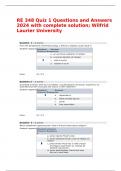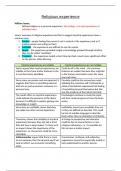Bridging program MBA 2019-2020
Dr. Alain Praet
[E-mailadres]
,Part 1: Value.................................................................................................................................... 8
Chapter 1 – introduction to corporate finance ................................................................................. 8
1. Corporate investment and financing decisions ...............................................................................8
1.1. Investment decisions ...............................................................................................................9
1.2. Financing decisions ..................................................................................................................9
1.2.1. Exercises ........................................................................................................................................ 10
1.3. What is a corporation? ..........................................................................................................11
1.3.1. Types of corporations (3) .............................................................................................................. 11
1.3.2. Disadvantages of being a corporation .......................................................................................... 12
1.4. Role of the financial manager ................................................................................................12
2. The financial goal of the corporation ............................................................................................13
2.1. Shareholders want managers to maximize market value......................................................13
2.1.1. Profit maximization ............................................................................................................13
2.1.2. Shareholders want three things .................................................................................................... 13
2.1.3. The investment trade-off .............................................................................................................. 14
3. Agency problem ............................................................................................................................14
3.1. Agency cost ............................................................................................................................14
3.2. Solutions for the agency problem (6) ....................................................................................15
4. Summary .......................................................................................................................................16
Chapter 2 – How to calculate present values ................................................................................. 17
1. Future values and present values ..................................................................................................17
1.1. Future values .........................................................................................................................17
1.2. Present value .........................................................................................................................18
1.2.1. The single period case ................................................................................................................... 18
1.2.2. Valuing an investment opportunity ....................................................................................19
1.2.3. Advantage of using present values ............................................................................................... 20
1.2.4. Risk and present value .................................................................................................................. 20
1.3. Net Present Value ..................................................................................................................20
1.3.1. Present value rules ........................................................................................................................ 21
1.4. Multiple cash flows ................................................................................................................21
1.4.1. Example ......................................................................................................................................... 21
2. Looking for shortcuts – perpetuities and annuities .......................................................................22
2.1. Perpetuity ..............................................................................................................................22
2.1.1. Example (slide 24) ......................................................................................................................... 22
2.2. Annuity ..................................................................................................................................23
2.2.1. PVAF .............................................................................................................................................. 24
2.2.2. Valuing annuities due .................................................................................................................... 24
3. More shortcuts – growing perpetuities & annuities......................................................................24
3.1. Constant growth perpetuity ..................................................................................................24
3.2. Growing annuity ....................................................................................................................25
3.3. PV summary ...........................................................................................................................25
4. How interest is paid and quoted ...................................................................................................25
4.1. EAR & APR ..............................................................................................................................25
5. Summary .......................................................................................................................................26
Chapter 3 – Valuing bonds ............................................................................................................. 27
1. Bonds Terminology........................................................................................................................27
2. Valuing a bond ..............................................................................................................................28
2.1. Semi-annual coupons and bond prices ..................................................................................29
2.2. Valuing a bond as an annuity .................................................................................................29
2.3. Financial calculators ..............................................................................................................30
2.4. Bond rates of return ..............................................................................................................30
2 CORPORATE FINANCE | Bridging program MBA 2019-2020
, 3. Maturity and prices .......................................................................................................................31
3.1. General rules .........................................................................................................................32
3.2. Duration and volatility ...........................................................................................................32
3.2.1. Duration ........................................................................................................................................ 32
3.2.2. Volatility ........................................................................................................................................ 32
3.2.3. duration – general rules ................................................................................................................ 33
4. Term structure of interest rates ....................................................................................................34
4.1. Terminology ...........................................................................................................................34
4.2. Spot rates, bond prices and the law of one price ..................................................................35
4.3. Measuring the term structure ...............................................................................................35
4.4. Why the discount factor declines as futurity increases .........................................................35
4.4. Explaining term structure ......................................................................................................35
4.4.1. Expectations theory of the term structure ................................................................................... 36
4.4.2. Introducing risk ............................................................................................................................. 36
4.4.3. Inflation and term structure ......................................................................................................... 36
5. Real and nominal interest rates ....................................................................................................37
5.1. Index to track the general level of prices ..............................................................................37
5.2. Interest rates and inflation ....................................................................................................37
5.3. Indexed bonds and the real rate of interest ..........................................................................38
5.4. What determines the real rate of interest?...........................................................................38
5.5. Inflation and nominal interest rates ......................................................................................39
6. Default risk ....................................................................................................................................40
6.1. Rating agencies ......................................................................................................................40
6.2. Sovereign bonds and default risks .........................................................................................42
7. Summary .......................................................................................................................................43
Chapter 4 – The Value of Common Stocks ...................................................................................... 44
1. How common stocks are traded ...................................................................................................44
1.2. Stock listings ..........................................................................................................................45
2. How common stocks are valued ...................................................................................................46
2.1. Expected return .....................................................................................................................47
2.2. Dividend Discount Model ......................................................................................................48
2.2.1. What if H goes to infinity? ............................................................................................................ 48
2.2.2. Assumptions:................................................................................................................................. 49
3. Estimating cost of equity capital ...................................................................................................49
3.1. Market capitalization rate .....................................................................................................49
3.2. Return measurements ...........................................................................................................50
3.3. Dividend growth rate .............................................................................................................50
4. Stock price and earnings per share ...............................................................................................50
5. Valuing a business .........................................................................................................................51
5.1. Discounted free cash flow model ..........................................................................................51
5.2. Valuation format....................................................................................................................51
5.2.1. Estimating horizon value ............................................................................................................... 51
5.2.2. Valuing a business or project ........................................................................................................ 52
5.3. Cash flow ...............................................................................................................................52
5.3.1. Free cash flow ............................................................................................................................... 52
5.3.2. Cash flow to creditors and stockholders ....................................................................................... 53
6. Summary .......................................................................................................................................55
Chapter 5 – Net present value and other investment criteria ......................................................... 56
1. A review of the basics....................................................................................................................56
1.1. Points to remember about NPV (3) .......................................................................................57
1.2. Book rate of return ................................................................................................................58
1.3. Example .................................................................................................................................59
3 CORPORATE FINANCE | Bridging program MBA 2019-2020
, 2. Payback .........................................................................................................................................59
3. Internal rate of return ...................................................................................................................60
3.1. Calculating the IRR .................................................................................................................61
3.2. The IRR rule............................................................................................................................62
3.3. Problems/pitfalls with IRR (4): ...............................................................................................62
3.4. The verdict in IRR ...................................................................................................................63
4. Choosing capital investments when resources are limited ...........................................................64
4.1. Profitability index...................................................................................................................64
5. Summary: ......................................................................................................................................66
Chapter 6 – Making investment decisions with the net present value rule ..................................... 67
1. Applying net present value rule ....................................................................................................67
1.1. the rules .................................................................................................................................67
1.1.1. RULE 1: Only cash flow is relevant ................................................................................................ 67
1.1.2. RULE 2: estimate CF on an incremental basis ............................................................................... 68
1.1.3. RULE 3: Treat inflation consistently .............................................................................................. 69
1.1.4. Rule 4: Separate investment and financing decisions ................................................................... 70
2. Example calculating the CF, NPV and Tax shield ...........................................................................71
3. Using the NPV rule to choose projects. .........................................................................................74
3.1. Problems ................................................................................................................................74
4. Summary .......................................................................................................................................76
PART 2: Best practices in capital budgeting.................................................................................... 77
Chapter 10 – Project analysis ......................................................................................................... 77
1. The capital investment process .....................................................................................................77
1.1. Items for consideration .........................................................................................................77
1.2. How to handle uncertainty ....................................................................................................78
2. Sensitivity analysis ........................................................................................................................78
2.1. Limits to sensitivity analysis ...................................................................................................78
2.2. Scenario analysis ....................................................................................................................81
2.3. Break-even analysis ...............................................................................................................82
2.3.1. Break-even analysis table.............................................................................................................. 82
2.3.2. Accounting break-even point ........................................................................................................ 83
2.4. Operating leverage and the break-even point ......................................................................84
3. Monte Carlo simulation.................................................................................................................85
3.1. Modelling Process ..................................................................................................................85
4. Flexibility and real options ............................................................................................................86
4.1. Decision trees à EXAM .........................................................................................................86
4.2. Real options ...........................................................................................................................86
4.2.1. Option to expand .......................................................................................................................... 86
5. Summary .......................................................................................................................................87
PART 3: Risk .................................................................................................................................. 88
Chapter 7 – Introduction to risk and return ................................................................................... 88
1. Real returns on major assets classes .............................................................................................88
1.1. Average rates of return and risk Premia 1900-2014 (US) ......................................................89
1.2. Using historical evidence to evaluate today’s cost of capital ................................................90
1.2.1. 2 reasons that history may overstate the risk premium demand today ....................................... 91
1.3. Dividend yields and the risk premium ...................................................................................92
2. Measuring portfolio risk ................................................................................................................93
2.1. Variance and standard deviation ...........................................................................................94
1.2. How diversification reduces risk ............................................................................................96
3. Calculating portfolio risk ...............................................................................................................97
4 CORPORATE FINANCE | Bridging program MBA 2019-2020











